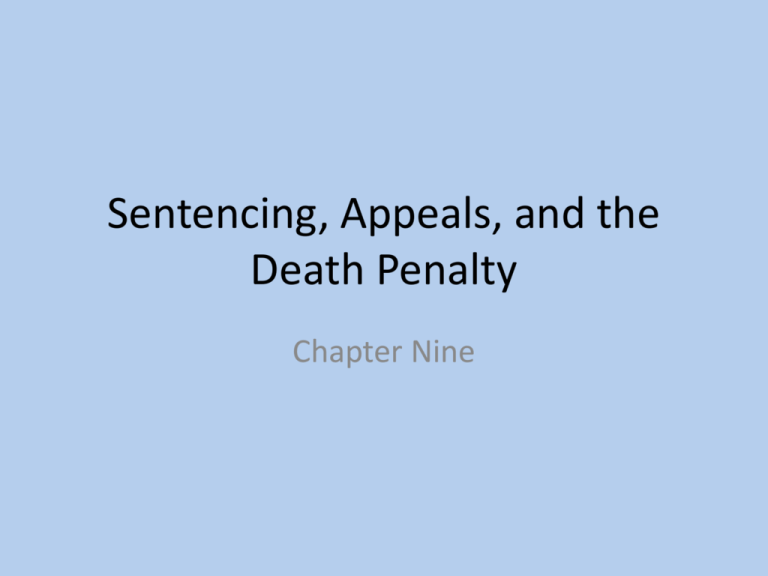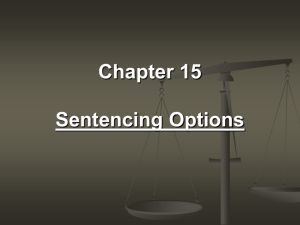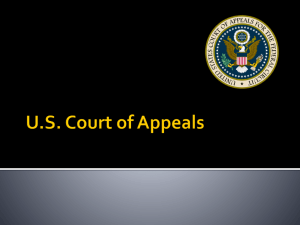Sentencing, Appeals, and the Death Penalty
advertisement

Sentencing, Appeals, and the Death Penalty Chapter Nine Incarceration Trends in America • From 1980 to 2008, the number of people incarcerated in America quadrupled-from roughly 500,000 to 2.3 million people • Today, the US is 5% of the World population and has 25% of world prisoners. • Combining the number of people in prison and jail with those under parole or probation supervision - 1 in every 31 adults, or 3.2 percent of the population is under some form of correctional control Contributing Factors • Inner city crime prompted by social and economic isolation • Crime/drug arrest rates: African Americans represent 12% of monthly drug users, but comprise 32% of persons arrested for drug possession • "Get tough on crime" and "war on drugs" policies • "Three Strikes"/habitual offender policies • Zero Tolerance policies as a result of perceived problems of school violence • 35% of black children grades 7-12 have been suspended or expelled at some point in their school careers compared to 20% of Hispanics and 15% of whites Cost of Incarceration • About $70 billion dollars are spent on corrections yearly • Prisons and jails consume a growing portion of the nearly $200 billion we spend annually on public safety If a criminal defendant pleads guilty or is found guilty by a judge or jury, then the judge must impose a sentence. Sentencing is arguably a judge’s most difficult responsibility. State and federal legislatures enact penal codes that specify appropriate punishments for each statutory offense or class of offense. There are currently five types of punishment used in the United States: fines, probation, intermediate punishments, imprisonment, and death Within limits, judges are able to tailor punishments to fit the crime and the offender: • Impose a combination of sentences • Suspend the imprisonment portion of a combination sentence or they can suspend the entire sentence • Can give the offender credit for jail time and deduct that from any prison sentence • May impose a sentence of time served • Order prison sentences to run concurrently or consecutively Types of Sentencing • Indeterminate Sentencing: sentence with a fixed minimum and maximum term of incarceration (sentence of 10-20 years with not less than 5 and no more than 25) • Determinate Sentencing: sentence with a fixed period of incarceration – Flat-time: judges can select between probation and incarceration but have little discretion in setting the length of prison sentence – Mandatory: specified number of years of imprisonment is provided for each crime – Presumptive: legislature provides a sentence range and judge must provide written reasons as to why they have gone outside of the range and its subject to appellate review Philosophical Rational for Punishment 1. Retribution: implies revenge for an offense committed 2. Incapacitation: removal or restriction of freedom for those found to have violated criminal laws 3. General Deterrence: prevention of people in general from engaging in crime by punishing specific individuals and making examples of them 4. Rehabilitation: attempt to “correct” the personality of the offender through educational, vocational, or therapeutic treatment 5. Restoration: seeks to restore the health of the community, repair the harm done, meet victim’s needs, and requires the offender to contribute to those repairs 6. Restitution: seeks repayment through money or services. When the first European settlers arrived in America they brought with them the legal systems from their native countries, with included the penalty of death for a variety of offenses. The earliest recorded lawful execution in America was in 1608 in the colony of Virginia. Since then 19,000 legal executions have been performed in the United States. [3% women] From 1977 to 2007: • 975 people have been executed (over half of those in Texas, Virginia, and Oklahoma) • Texas has executed more than three times as many offenders as any other state • Almost all have been male • 58% white and 34% black Between 1968 and 1972 a series of lawsuits challenged various aspects of capital punishment. During this period, an informal moratorium on executions was observed. • Furman Decision: held that capital punishment was unconstitutional because they gave the jury complete discretion to decide whether to impose the death penalty or a lesser punishment [did not rule that the death penalty itself was unconstitutional only they way in which it was being administered] Practical effect of the Furman decision: Supreme court voided the death penalty laws in 35 states and more than 600 had their death sentences vacated. By the fall of 1974, 30 states had enacted new death penalty statutes designed to meet the court’s objections. The constitutionality of the new death penalty statutes was quickly challenged in 5 cases. The most dramatic effect of Gregg was the resumption of executions in Jan 1977. Five methods of execution: Hanging, lethal injection, lethal gas, electrocution, and firing squad 32 states + the US gov’t and US military have capital punishment Gregg limited death penalty to those offenders convicted of capital or aggravated murder; treason, espionage, drug trafficking in large quantities, and killing any public officer (added in 1994 federal crime bill) Supreme Court has barred states from executing inmates who have developed mental illness while on death row, the mentally retarded, and those who are under the age of 18 (Roper v. Simmons) Procedural Reforms Approved in Gregg: • Bifurcated trial: two-stage trial, if in the guilt phase the defendant is found guilty then at the penalty phase the jury must determine whether the sentence will be death or life in prison • Guideline for Judges and Juries: must be provided with lists of aggravating and mitigating factors and must consider any mitigating factors offered by the defense • Automatic Appellate Review: generally considered by the state’s highest court; if either the conviction or sentence is overturned then the case is sent back to trial court – can be appealed through the state and federal levels Appeals • Cases in NC are appealed from the NC District or Superior Courts to the Court of Appeals; or from the Court of Appeals to the NC Supreme Court • Cases in the US are appealed from the District Courts to the Appellate Courts; or from the Appellate Courts to the US Supreme Court Appeals • These courts have appellate jurisdiction – the ability to hear a case on review. • Courts with appellate jurisdiction use the writ of certiorari when deciding which cases to hear – meaning the lower court must deliver its records to the higher court for review. Rules for Appeals Defendants can appeal their convictions either on legal grounds or on constitutional grounds. However, they are not entitled to present new evidence or testimony on appeal if that evidence or testimony could have been presented at trial. If you accepted a plea bargain, you can’t appeal. If new evidence is discovered that was unknown or unknowable to the defense at trial, then an appeal can sometimes be made on the basis of new evidence. Rules for Appeals Continued…. Burden of proof shifts to the defendant. They have to show why they’re innocent. Generally notice to appeal must be filed within 30 to 90 days. Nearly 80% of state trial court decisions are affirmed on appeal. The appeals process is different from the trial process in several ways: 1. Most arguments presented are made in writing rather than in open court. 2. A panel of 3 judges hears the case, instead of a judge and jury 3. Arguments relate to the defendant’s rights, rather than the actual crime.








